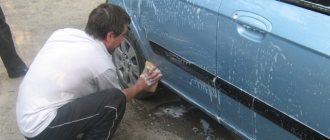Published: March 28, 2016
Rating:
Tags:Fine for tinting
Tinting on car windows is not only a tuning element, but also a guarantee of passenger safety.
If you are planning to apply it to your car, please note that tinting in some cases is prohibited by law and is punishable by a fine. Therefore, before sticking a strip of tinting film, you should familiarize yourself with the rules for tinting, but as an alternative, use a visor on the windshield with which there will be no problems.
Tint strip on windshield
Standards
According to current legislation, the width of the strip of tint film on the windshield at the top should not exceed 14 cm. Despite the fact that this requirement is clearly stated in the regulations, many problems arise with such indicators. Most often this happens because the measurement is made not from the edge of the tint film itself, but from the edge of the windshield. Such mismatches can also occur if the film is glued unevenly in the upper part of the windshield (in the presence of triplex).
Then you should refer to GOST:
- the border is measured taking into account all 3 points;
- width (in cm) is calculated based on the arithmetic average of these indicators.
Some traffic police employees do not take such indicators into account, citing the fact that GOST does not have legislative force.
It should also be noted that tinting the upper part of the windshield is allowed only with a light film with a transparency of at least 70%. That is, the sunscreen should be almost completely transparent.
If you decide to stick a tint strip on the top of the windshield, you need to adhere to the requirements of the traffic rules. Please note that 14 cm is the thickness of the film over the entire glass, and not just in the center, as many drivers believe.
Strip selection
Gluing the strip with your own hands is quite simple. Initially, you should choose the right material. There are special strips of standard size (14 cm) with different inscriptions or shades. But as for the latter, we should not forget the standard regarding light transmittance.
The cheapest and at the same time simplest option is to purchase a standard strip for tinting the windshield of a certain car brand. It meets all standards according to GOST. So you don’t need to adjust it to size and worry about fines from traffic police officers.
In addition to the presented options, you can also pay attention to the stripes for tinting (size - 130 cm by 50 cm). In this case, the strip on the glass is divided into 2 equal parts (rear and front glass).
Types of stripes on the windshield
Fine for non-compliance
Penalties for violation of the glass tinting procedure, including any violation of the GOST 32565-2013 standard, are prescribed in the Code of Administrative Offenses.
Mesh instead of tinting on the front windows, read about it here.
Information about athermal tinting according to GOST is in this publication.
Thus, Article 12.5 of the Administrative Code, paragraph 3.1 states that for violating this provision, the driver faces a fine of 500 rubles . If it is paid within 20 days, it is subject to a 50% discount. (In accordance with Article 32.2 of the Administrative Code, clause 1.3).
Obviously, windshield tinting is a permitted and completely legal way to decorate your vehicle. The driver just has to choose the desired color and design of the sticker and carefully paste it over the windshield.
Preliminary stage
The stripes should be applied to the windshield in a dry room. If you are going to carry out such an operation outdoors, the weather should be warm and calm.
Initially, you should prepare the surface of the car. To do this, you need to use a soap solution (10-20%). You can also use regular shampoo.
If soapy water is not suitable for you, a special glass degreaser will do. Please note that the substance should not be hazardous to metal surfaces.
After the glass is completely cleaned and well dried, you can begin gluing the strip.
Preparation
It is more advisable to carry out all work in a room with low humidity. If there is none, and the procedure will take place outdoors, then wait for warm and windless weather. Moisture that gets under the tint will cause streaks and peeling. The car needs to be washed and the areas where the film is applied should be treated with a soap solution. In difficult cases, you can use a special car shampoo or degreaser for smooth surfaces. Afterwards the glass must be dried with a hairdryer. Do not touch the clean surface with your hands or other objects, otherwise greasy stains may appear.
Film application
Please note that you need to cut off the tint strip with a margin (5-7 cm more). The strip should only be applied to well-washed glass. Otherwise, the film will simply fall off. Next, the following actions are performed:
- the outside of the glass is treated with soapy water;
- carefully apply the film itself (make sure there are no air bubbles);
- excess pieces (2-5 cm) are cut off;
- The protective layer of the strip is removed with smooth movements, and at the same time the film is moistened with a soap solution from a spray bottle;
- on the inside, the glass is also moistened with a soap solution, and a film is applied;
- the material is leveled and adjusted (spare centimeters are immediately removed);
- use a non-sharp spatula to remove air bubbles;
- Use a technical hairdryer to thoroughly dry the surface.
The tint film dries completely only after 2 days. Therefore, during this period you should not actively operate the vehicle, especially in bad weather conditions.
Applying film to windshield
How to remove
When you are tired of the film or the result is not as desired, you may need to remove the strip. There are several methods to remove it.
The following items should not be used during film removal:
- sharp knives made of hard steel;
- sandpaper;
- polishing materials;
- blades.
Rough methods may damage the glass itself. This often leads to the need to completely replace the windshield, which is quite expensive.
You can remove a tint strip using two methods:
- using a hairdryer;
- no hairdryer.
To remove the tint strip using the hot method, it is better to invite another assistant, since it will be more convenient to work on both sides of the car at the same time. Meanwhile, as one person warms up the work surface on one side, the second carefully removes the film.
It is necessary to monitor the degree of heating. If the surface is overheated, the glass may crack, and the film may melt, making it almost impossible to remove.
Benefits of tinting
Despite the fact that window tinting is partially prohibited by law. This tuning element has undeniable advantages:
- protects glass from mechanical damage;
- prevents the windshield from cracking when a crack or chip forms;
- in the event of an accident, the glass will not fall out on passengers, since it will be held in place by the tint film;
- protects the car from ultraviolet rays and interior fading;
- keeps the cabin cool in summer and warm in winter;
- protects from oncoming headlights;
- preserves personal space in the car interior, since everything is hidden from prying eyes.
If you decide to apply such a tuning element to your vehicle, then measure in advance how much film you need (plus 10-20 cm for reserve).
The pasting process is simple and anyone can do it. But when applying such an addition to your car, you should remember the legal requirements. Otherwise, administrative penalties are inevitable.
For many who drive OPEL Mokka, it is no secret that the windshield in our cars is too large
.
Such dimensions would make sense, otherwise 20% of the glass area does not in any way affect the visibility of the road situation.
During the next audit, in my old bins, I came across a 1 m linear tinting film for the rear lights.
I bought it, I don’t even remember when, for a VAZ 21120, but I never started using it. In general, it was lying in a warm room, the adhesive layer was preserved very well and I decided not to use it for gluing the lanterns, but to make a stripe on the forehead. Once I’ve decided, I have to do it. So, in order to do everything efficiently, it is necessary:
1. Wash the glass well, both from the outside (due to the fact that we will heat and form a film on the outer part of the windshield) and from the inside (for high-quality gluing of the film in place).
2. Mark the glass to facilitate future gluing of the film from the interior. 3. Detergent for washing, cleaning and polishing glass, spray. 4. Cutter. 5. Masking tape (according to Feng Shui), for some reason I didn’t have it, so I used electrical tape (I had to wipe the glass with solvent after removing it). 6. An industrial hair dryer, or a hair dryer, because we set the temperature within 250-300 degrees. 7. Clean rags for washing and wiping glass. 8. A sheet or any rag to cover the dashboard. Having collected everything I needed, I began to carry out my plans.
Tinting standards
The width of the strip glued to the windshield should not exceed 14 cm. This simple, at first glance, statement contains a small catch, since measurements are always taken not from the edge of the film, but from the edge of the element itself. A crookedly glued strip may have a thickness of 14 cm in the center, but due to the bending of the triplex, it will slide down a couple of centimeters along the edges. Not many people know that the sequence of measurements is described in sufficient detail in the notorious GOST 5727–88. The standard, of course, does not have the force of law, but the measurements taken by the inspector must comply with it:
- The boundaries of normative fields are measured at three points.
- The width of the normative field is calculated as the arithmetic mean of these numbers.
The measurements taken must be recorded in the appropriate act, according to which a protocol is drawn up. Violations committed and recorded during measurements, as well as the use of instruments that are not included in the uniform suitcase of traffic police officers (for example, a construction tape), can be used for defense in court, although they are unlikely to be a good defense in themselves. The light transmittance of the tinting film must meet the general requirements - 70% (glass element + film). Those. Tinting is only permissible with a very light film.
#7 24.03.2010 15:38:10
Deputy:
Fedotudalets, I also know that it is correct to measure vertically, and not along the plane of the glass, but the traffic police don’t know this, and I can’t find the norm of the law or GOST. Maybe you can help me find it?
Guests of standardization and metrology need to be dug. In general, judging by GOST. measurements should be taken from inside the car. Since the % visibility/invisibility ratio is interpreted from the driver’s visibility side. Accordingly, following the guest, the lights must be measured from the passenger compartment, and guided by other docks, measurements are made only when registering a vehicle, undergoing maintenance, or by technical supervision employees at a stationary post. So GOST R 51709-2001, and GOST 5727-88. You need to study. We also need to find out whether they have been canceled by some resolutions. But judging from a superficial reading of the external measurements, it is obviously bullshit.
PS Personally, I don’t care how or what is measured, I’m more concerned about who, where, than and under what circumstances.











